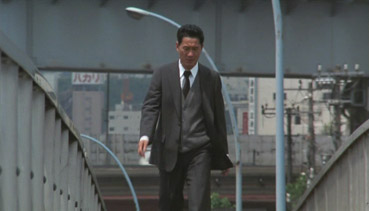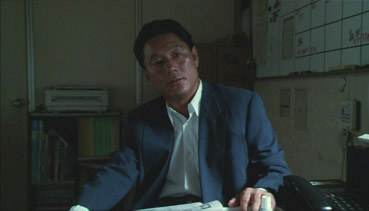|
My first encounter with Takeshi Kitano (or to use the correct Japanese naming convention, Kitano Takeshi), as it doubtless was for many western viewers, was his performance in Ōshima Nagisa's 1983 Merry Christmas Mr. Lawrence as the moon-faced Sergeant Hara, whose blend of unforgiving brutality and almost child-like self-amusement made him the film's most intriguing character, and one who ultimately proved so oddly sympathetic that his final freeze-frame was a genuine heart-breaker.
My first experience with Kitano the director was, by any true cineaste standard, shamefully belated. It sometimes happens to the likes of us. I'm not making excuses (oh well, perhaps just a bit) when I say that when you watch and write about films for a hobby rather than a profession, the window of exposure to them is usually somewhat smaller than it is for a full-time film journalist or critic. Us part-timers, or at least those of us without wealthy parents or trust fund accounts, are also working stiffs who have to put in a good many hours a week to pay for that DVD player and big TV and the house to store it in. Even those who work in film – fellow reviewer Camus is a good example – have families and other commitments to juggle and unreasonable deadlines demanded these days by unsympathetic production companies to meet. As a result, there are films and filmmakers that inevitably slip us by, people and works that we sometimes catch up with long after others have laid claim to their discovery. Such is the case with Kitano. Now an almost rabid enthusiast for his work and for all aspects of Japanese culture, I remain to this day surprised that he slipped beneath my radar for so long.

In Japan, Kitano's media fame was considerable even before he began directing films and it's grown considerably since. Starting out as one half of The Two Beats, a successful mansai comedy duo (a uniquely Japanese style of stand-up that involves almost unbroken quick-fire verbal exchanges between two or more performers), his roles later expanded to include those of TV comedy performer and show presenter, film actor, newspaper columnist, author, poet, painter, and movie director. Previous to this he had also been a boxer and a tap dancer. He can still tap dance – on my last visit to Japan he paused the humour on one of his many TV appearances to impressively demonstrate that he'd not forgotten his moves.
His first directing gig on the 1989 Violent Cop [Sono otoko, kyôbô ni tsuki] came about almost by chance when veteran filmmaker Fukusaku Kenji was unable to helm the film as originally intended, and Kitano put himself forward as a replacement. I can only imagine the confidence he must has exuded to convince those with the purse strings to let this cinematically inexperienced TV comic turned actor call the filmmaking shots. But he delivered the goods with style, and a new career for Kitano began. In a relatively short space of time he was making his mark on the international circuit.
But just five years after his debut feature, it nearly all came to an abrupt halt. In August 1994, shortly after completion of his comedy film Getting Any? [Minna Yatteruka!] and his acting duties on the woeful film adaptation of William Gibson's Johnny Memonic, he was involved in a serious motorcycle accident that left one half of his body partially paralysed. A number of surgical procedures were required to restore a degree of facial movement, and for a while it looked as if his glory days were well and truly over – I remember a friend in Japan telling me that in his first TV appearances following the accident he seemed like a shell of his former self. And yet less than two years later he completed the autobiographical Kids Return, one of his most captivating films and his biggest success yet on home turf. It was also following the accident that he took up painting, a therapeutic vocation that made its way into his 1997 film Hana-bi, which also marked his return to screen acting and remains one of his most justly celebrated works as a director. In no time at all he had re-established himself as Japan's busiest and most prominent media figure.
Sonatine was his fourth film as director and one I was no more aware of back in 1996 than I was of its three predecessors. I came across it by happy chance – the BBC were celebrating one hundred years of cinema by screening a hundred great movies, an enjoyably eclectic mixture of acknowledged masterpieces and what were clearly personal favourites on the part of whoever was in charge of their selection (a little research suggests that then BBC editor Steve Jenkins was the key player here). One of the latter group was Sonatine. It was Japanese and I didn't know it and that alone was enough to grab my attention, particularly given the illustrious company in which it was seated. It was also one of the few even close to contemporary works on the list, and the Radio Times write-up made for a persuasive sell. I was blown away. I mean, really blown away, not by any spectacle or visual beauty, but by the filmmaking itself: the unhurried but immaculately timed editing, the almost zen-like silences, the expressive use of wide shots and close-ups, the unflinching and abrupt violence, the unexpected tenderness, the offbeat humour, the sudden switches of tone, the daring surrealism, and the sublime manner in which these diverse elements were harmonised.

Since then I've been something of a Kitano junkie, tracking down works on tape and disc and arranging cinema screenings of the films when they secured UK releases. Curiously, his more recent works have yet to see the light of day here. The oddball but still intriguing Takeshis' was once on Artificial Eye's release list but mysteriously failed to appear, and despite its screening at the 2007 London Film Festival, his similarly introspective Kantoku – Banzai! has failed to make it's way into cinemas or onto disc. It's the same story for his most recent film, Akiresu to kame [Achilles and the Tortoise], whose appearance on UK screens was also restricted to a single LFF screening. His films are now made under the umbrella of his own production company, Office Kitano, which has quietly become involved in the production and distribution of a number of other international works – scan the end credits of Samira Makhmalbaf's Blackboards [Takhté siah] (2000), for example, and you'll find a thank-you to the company.
In spite of the more serious direction his acting and directing roles have taken, Kitano has remained firmly attached to his comedy roots. Much of his TV work is humour-based (his madcap Takeshi's Castle has a serious international following), comic moments pepper even his more serious dramas, and a link to the mansai days has been retained through his dual credits as Kitano Takeshi for his filmmaking duties and Beat Takeshi for his self-directed acting roles. One suspects it's this self-created duality of identity that gave rise to Takeshis', in which two very different aspects of his own personality are given visually identical bodily form.
The Takeshi Kitano Collection was first released as a six-disc box set back in October 2008 by Second Sight and consists of Kitano's first six features as director. Included here is some of his very finest work, plus one film whose appreciation really will be a matter of taste and tolerance. Two of the films – A Scene at the Sea and Kids Return, both gorgeous in their way – Takeshi does not appear in, and one of them – Sonatine – is my favourite Kitano directed film to date, and that's a tough call in the light of A Scene at the Sea, Kids Return, Hana-Bi, Kikujiro and Dolls.
On the release of this set, I had every intention of reviewing it, but soon found myself without the time to do each of the films the justice I believed they deserved. The news that Second Sight was to this year release all six films individually opened a second window of opportunity, one that started to creak shut when a series of circumstances – site down time, holiday, family illness – looked set to halt me in my tracks yet again. But these are important films to me and ones that I believe all fans of auteurist outsider cinema should make it a priority to see, if only to disagree with my enthusiasm, but hopefully to share it.
The titles will be reviewed individually as stand-alone discs, but all six are still available as the aforementioned box set and the discs are identical in both incarnations, with the same transfers and extra features. A welcome collection they are, but definitive they are unfortunately not, with the transfers some way short of the quality the films themselves cry out for, and the subtitles, although for the most part an accurate enough interpretation of the original Japanese, sometimes do not provide translations of small talk and, in the case of A Scene at the Sea, a crucial piece of written text. The films are listed below and the links will become active as the titles are reviewed over the coming two weeks, as well as being posted on the front page as new reviews.
Update: due to personal circimstances, Sonatine and Kids Return ended up not being reviewed. I later reviewed Sonatine as part of a BFI Blu-ray release, also titled (altough this time without the definite article) Takeshi Kitano Collection.
Violent Cop / Sono otoko, kyôbô ni tsuki (1989)
Boiling Point / 3-4 x jûgatsu (1990)
A Scene at the Sea / Ano natsu, ichiban shizukana umi (1991)
Sonatine (1993) (Blu-ray review)
Getting Any? / Minnâ-yatteruka! (1995)
Kids Return (1996)
|